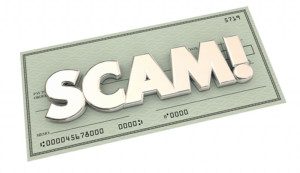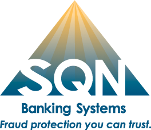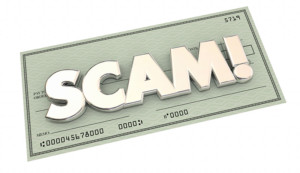10 Signs of Fake Checks – How to Scan Checks for Legitimacy

While the use of paper checks has been declining, criminals have been increasingly targeting mailboxes to commit check fraud. In February 2023, the Financial Crimes Enforcement Network (FinCEN) sent out an alert regarding the rise in mail theft-related check fraud schemes. Criminals also take over accounts and steal information to print their own fake checks, or they create fake checks that aren’t even linked to a real account.
But when one of your banking customers deposits a check, how exactly do you know if the check is fake or legitimate? Whether you’re accepting the check over the counter at the branch or letting it clear from a client’s account, you need to be able to spot fakes. To help you out, here are 10 signs of fake checks followed by tips on how to train your employees, educate your customers, and reduce the risk of check fraud at your financial institution.
10 Visual Signs of Fake Checks
If you or your fraud detection team notices any of the following issues, you should put a hold on the availability of funds to the extent allowed at your bank. Whenever possible, you should also talk with customers about the origin and legitimacy of the check. Sometimes, a short conversation and a few questions at the branch can prevent a customer from falling prey to a fake check scam.
1. Irregular Perforations
Check the sides of your check for any rough edges. Genuine checks feature at least one rough edge and are perforated. Scammers are now printing their own checks with MICR capability on their own printers. These checks often lack perforations or have difficult-to-find micro-perforations. Also, the MICR numbers tend to be shinier than usual.
2. Irregular Check Numbers
In some circumstances, fake checks may include abnormalities in their check numbers. This includes the following irregularities:
- Out-of-Place Numbers – If a check is genuine, it should have a check number printed in the top right-hand corner. Keep an eye out for checks with the number printed somewhere else.
- Out-of-Order Numbers – Out-of-sequence check orders may mean that your client lost a checkbook and started writing checks from a new one, but in other cases, it can be a sign of a fake. If you receive a much lower check number than usual from a customer, look into the issue. Also, be on alert for duplicate check numbers.
- Mismatched Numbers – To see if you have a real check, compare the check number in the top right corner against the number in the MICR line. The MICR line includes the account number, routing number, and check number. If the MICR line does not match the check number, the check is most likely a fake.
- Low Check Number – While a low check number does not necessarily imply that a check is fake, it does suggest the establishment of a new checking account and a higher risk of fraud. Remember that 90% of bad checks are drawn from checking accounts that are less than a year old, so this could be cause for concern. Watch for personal checks with numbers in the low three digits, and business checks with numbers in the low four digits.
3. Incorrect Routing Number
Fraudulent checks frequently have routing numbers that do not match the bank name on the check. You can easily check by searching for the bank’s correct number online or using the Federal Reserve Bank Services website. If the routing number you find doesn’t match the name of the bank on the check, it is definitely a fake.
4. Stains or Discolorations
The presence of stains or discolorations is a common indicator of a fraudulent check. This may happen if a scammer tampers with the check or erases something. When looking for fake checks, check for color smears when rubbing. Genuine checks should be properly printed, with no rubbing or smearing. Try moistening your finger and lightly running it along the check’s print. If the ink spreads, you may have a fake.
5. Poor Paper Quality
Genuine checks are often printed on high-quality paper. If your check feels thin or slick, or if the paper is poor quality, you may be dealing with a fake.
6. Mismatched Numerical and Written Check Amounts
The check’s numerical and written amounts should always match. If they don’t, you likely have a fake. In some cases, the individual who wrote the check may have made a mistake, but even if they did, they will need to rewrite the check.
7. Misspelled or Missing Bank Names
Fake checks frequently include fictitious addresses or P.O. Box numbers in place of the bank’s actual address. Some poor-quality fakes even spell the bank’s name incorrectly. You can determine whether a bank printed on a check is legitimate by using the FDIC BankFind service or by calling the bank using the information provided on its official website.
Additionally, a genuine check should have the logo of the issuing bank. If the check contains a logo for a bank you’ve never heard of — especially one with a generic name like “National Bank” — or if the logo is faded or otherwise irregular, it is most likely forged.
8. Government or Corporate Checks with Different Print Styles
The typeface on corporate or government checks should be consistent in both design and print. If there are mismatched printing fonts or other printing flaws, the check may be fake. Often, this happens when thieves erase the data printed on the check and inflate the amount.
9. Issues With the Account Holders’ Details
The check’s drawee’s name and address should be typed. This info should not be printed, and it should not contain any spelling mistakes. Sometimes, the customer’s name and/or address are completely absent on a fake check.
10. Other Discrepancies
Examine presented checks to ensure there are no additional unusual aspects. Check that the check amount matches the spelled-out amount and that there are no spelling problems. Also, look for any parts that appear to have been wiped or altered.
How to Prevent Fake Checks From Leading to Losses
In addition to being aware of the visual signs of fake checks, you should also rely on fake check scanning technology based on AI and machine learning. Be aware that some of these tools can only analyze the structured data on the check and not the visual data. For example, structured data check, it knows that there is a high likelihood of fraud, and it can flag the check for review. includes phone numbers and addresses. If your check fraud software sees a phone number that has historically been linked to a bad actor on a
However, if you want to detect check fraud as effectively as possible, you need detection tools that also look at unstructured image data. Check Image Analysis solutions look for minute alterations that generally cannot be seen by the human eye. They analyze fixed points on the check including payor name and address, memo and signature line placement, fonts, layouts, and all other visual elements of the check. Then, the software generates a risk confidence score, and if the score is over a certain threshold, it puts the check in the manual review queue for your customers.
The Risk of Mobile Deposit Fake Check Scams
A lot of fake check scams right now use mobile deposit technology. For example, a scam artist might contact an account holder and ask them to deposit a check for $2,000, wire $1,800 to a foreign account, and then, keep the $200 as payment for services. However, not long after the account holder sends out the $1,800, their bank realizes the original check is a fake, and their account quickly goes into the red.
The bad actor may use all kinds of stories to trick someone into taking this action. They may convince the victim that they are being hired to test a new wiring service. They may even claim to be from the bank and testing the mobile capture deposit system. If they have the right technology, they might even do a deepfake that involves an AI-generated video of a person the account holder knows telling them to take these actions.
If someone deposits a fake check through your mobile app, you need the ability to spot it. This requires AI and machine learning tools that can analyze the images of a check. It also requires a well-trained manual review team.
Educate Your Customers About Fake Check Scams
Unfortunately, the weak link in most fake check scams is the account holder. The good news for banking professionals is that if the customer allows access to their account, they are generally liable for the losses, not your financial institution.
Unfortunately, however, that does not insulate you from financial or reputational consequences. If the customer abandons their overdrawn account in the wake of check fraud, you will be left to pursue the losses through collection activity which is an expensive way to recoup a small portion of losses and sometimes nothing at all. Beyond that, most customers blame their banks for fraud even if the incident was their fault, damaging your reputation.
To protect you bank and your customers, make sure your customers know about the different types of check fraud and how bad actors trick people into sharing account details. In particular, talk with customers about phishing scams, money order scams, and other customer-centric scams that fool people into sharing information or taking action.
Contact SQN Banking Systems for Help with Check Fraud
At SQN Banking Sytems, we offer comprehensive solutions to help financial institutions detect and prevent check fraud as well as other types of payment fraud. To protect your bank, contact us today. We’ll help you find tailored solutions for your unique risk profile.

